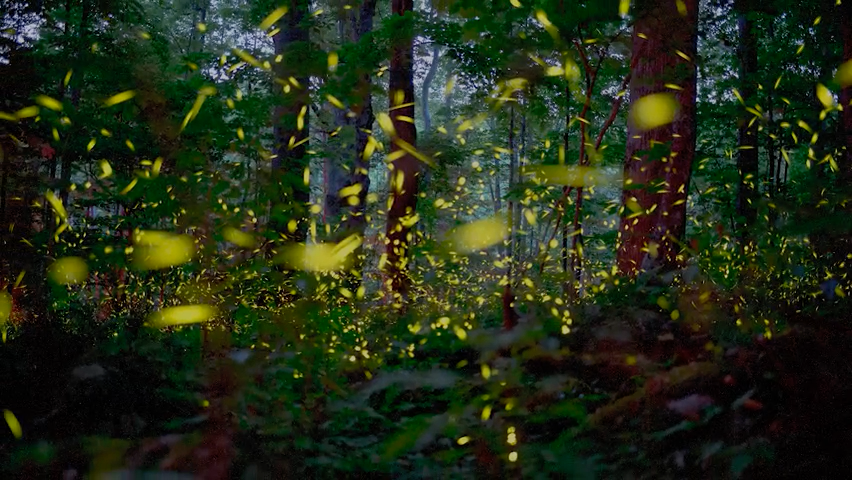KELLETTVILLE, Pennsylvania. — Every year, at the end of June, Peggy Butler and her husband, Ken, welcome visitors to rural northwestern Pennsylvania for the opportunity to glimpse the rare and seductive Photinus carolinus. This species of firefly flashes synchronously, creating dazzling light shows. The abundance of fireflies on their Forest County property — there are at least 17 species in addition to the synchronous firefly — led the Butlers to found the Pennsylvania Firefly Festival.
Launched in 2013, the annual event became so popular that the Butlers had to institute a lottery system to protect the fireflies that visitors so wanted to see. This year, 2,500 people applied for just 130 places.
The intense interest in the festival highlights how much Americans love fireflies. Summer nights spent watching fireflies (and debating whether or not they should be called fireflies) is a cherished tradition throughout the country. But this tradition could be threatened by climate change, according to a new study.
What is the biggest threat to fireflies?
Researchers have found that climate change is among the most serious threats to firefly populations in the United States. To understand what determines firefly abundance, researchers analyzed more than 24,000 surveys conducted by citizen scientists from 2008 to 2016 using the program Firefly Clock.
Other studies have established that short-term weather affects fireflies, which makes sense because their life cycles last between one and two years, with most of that time spent as larvae living in the soil, where they are particularly vulnerable. .
“What we were really surprised to find is that it’s also long-term weather patterns, like averages and things that are expected to change with climate change, that are actually the main drivers of firefly populations,” said Darin McNeil, study leader. researcher and assistant professor of wildlife ecology and management at the University of Kentucky.
Rising temperatures have a negative impact on fireflies, he said, and as some places become hotter and drier, their firefly populations could disappear.
Like the giant panda, fireflies are charismatic ambassadors for their less iconic brethren, shining a light on declining insect populations around the world.
“There are many insect species that are in urgent need of conservation work and scientific study,” McNeil said. “But sometimes it’s hard to get people excited about dung beetles, for example.”
Recent research has shown that Insect populations have fallen by 45% in the last 40 years, a collapse so extreme that scientists have labeled it “the insect apocalypse.” Anecdotal evidence suggests that firefly populations are also in decline, and 14 species of fireflies in North America have been assessed as threatened. The Bethany Beach firefly, found only off the coast of Delaware and Maryland, is critically endangered.
A symbol of fairy tales and childhood
For many people, even those who are afraid of other insects, fireflies evoke wonder, magic and nostalgia, a symbol of fairy tales and childhood.
“They’re friendly little bugs. They don’t bite. They don’t sting,” said Peggy Butler. “That light really attracts people to ask, ‘How do they do that?’ And that piques their curiosity.” She paused, laughing. “Sorry about all the puns.”
Capturing fireflies and marveling at their light is an experience shared across time and geography.
“They’ve been written and sung about for centuries,” said Sarah Lower, study co-author and assistant professor of biology at Bucknell University. “I mean, how fascinating is it that an insect produces its own light?”
Conservationists hope that by learning more and educating people about what harms fireflies, they will also help other insects that are harmed by the same things. In addition to climate change, fireflies are threatened by pesticides, light pollution and unrestricted development.

The Allegheny National Forest, where the Pennsylvania Firefly Festival is maintained, it is largely protected from some of these scourges of modern life.
“It’s very wild here. We have half a million acres of national forest where we live,” Butler said. “Fireflies prefer very dark places. There must be a lot of humidity and intact soils.”
The Butlers avoid pesticides, rarely mow their lawn and limit their use of outdoor lighting during the summer. Fireflies blink to attract mates, and light pollution interferes with their signaling.
Every year at the festival, guides lead small groups of participants into the forest to witness the synchronized glow of Photinus carolinus. It is often a powerful and emotional experience, especially for people who have never seen a firefly before.
“When we take them back into the forest, into total darkness, and they see that synchronous activity, they are amazed,” Butler said. “You can hear the murmurs. You can hear the ‘Wow, oh my God. Look at this.'”
Previously, Photinus carolinus was thought to live only further south in the Great Smoky Mountains. In the Smokies, mating displays by these insects are a “huge phenomenon,” Lower said, making the region a beacon for firefly tourists. It is not known whether Photinus carolinus exists elsewhere in the northern Appalachians, although Lower theorizes that it is possible, and they have been found in other parts of Pennsylvania.
Lower was a member of the team that first confirmed the presence of Photinus carolinus in the Allegheny National Forest in 2012, and now serves on the board of the Pennsylvania Firefly Festival, advising the organization on how to keep the event sustainable.
How are fireflies affected by climate change?


A map of firefly abundance and ideal weather conditions generated for the recent study shows hot spots in Pennsylvania, and McNeil called Pennsylvania “the heart of firefly country.” Maybe that’s why firefly is the state insect. But what climate change will mean for Pennsylvania’s beloved fireflies in the long term remains unclear.
Due to climate change, Pennsylvania is becoming hotter and wetter, with increased rainfall and more intense storms. Butler has seen how flooding can affect fireflies on his property.
“In 2015, we had a major flash flood in our area that destroyed the undergrowth about two weeks before the festival in the forest right behind us,” she said. “That year, and for two or three years afterward, we saw no synchronized fireflies in those areas.”
Lower said it’s too early to predict what will happen to fireflies in specific locations due to climate change, and the results will be different for each species and depend on their habitat requirements. “What concerns me most is whether this will change very quickly,” she said. “We actually don’t have a very good idea of how far fireflies can travel.”
McNeil said firefly populations may appear stable to people in Pennsylvania as climate change accelerates, although what’s really happening is a “species shift.” There is more than 100 species of fireflies in North Americaand some of these species, like the common Ursa Major firefly, named for its J-shaped flight path, may thrive even if other, less adaptable species are lost.
Opinion alerts: Get columns from your favorite columnists + expert analysis on top topics, delivered right to your device through the USA TODAY app. Don’t have the app? Download it for free from your app store.
Lower and McNeil encourage people to manage their properties in ways that benefit fireflies, by leaving dead leaves on lawns during the winter, for example, and to participate in community science around fireflies. The efforts of United States residents made this study possible and could make others possible in the many areas of firefly research that are understudied.
Collecting data on fireflies in your own backyard “can go a long way toward their conservation,” McNeil said. “And if you take your kids to count fireflies, they’ll be future conservationists.”
Fireflies may be small, but their presence – and diverse abundance – is important.
“We could probably lose all of our fireflies, and it wouldn’t have much of an impact on their day-to-day lives, plus summer nights would be a little less magical,” he said. “But fireflies serve as what we would call bioindicators, telling us something about the broader health of our ecosystem.”
Their disappearance is a warning, not only for insect populations, but also for us. “The question is,” McNeil said, “how many species can we lose before we see enormous consequences for human society?”
Kiley Bense covers climate change and the environment with a focus on Pennsylvania, politics, energy and public health. That column previously appeared in the Erie Times-News and originally appeared in Inside Climate News, an independent, nonprofit news organization covering climate, energy and the environment. It is republished with permission.
You can read diverse opinions from our USA TODAY columnists and other writers at First opinion pageon X, formerly Twitter, @usatodayopinion and in our Opinion newsletter.
This article originally appeared in the Erie Times-News: Americans love fireflies. But can fireflies continue to survive?





































